service indicator NISSAN MAXIMA 2023 Owner's Manual
[x] Cancel search | Manufacturer: NISSAN, Model Year: 2023, Model line: MAXIMA, Model: NISSAN MAXIMA 2023Pages: 494, PDF Size: 5.7 MB
Page 308 of 494
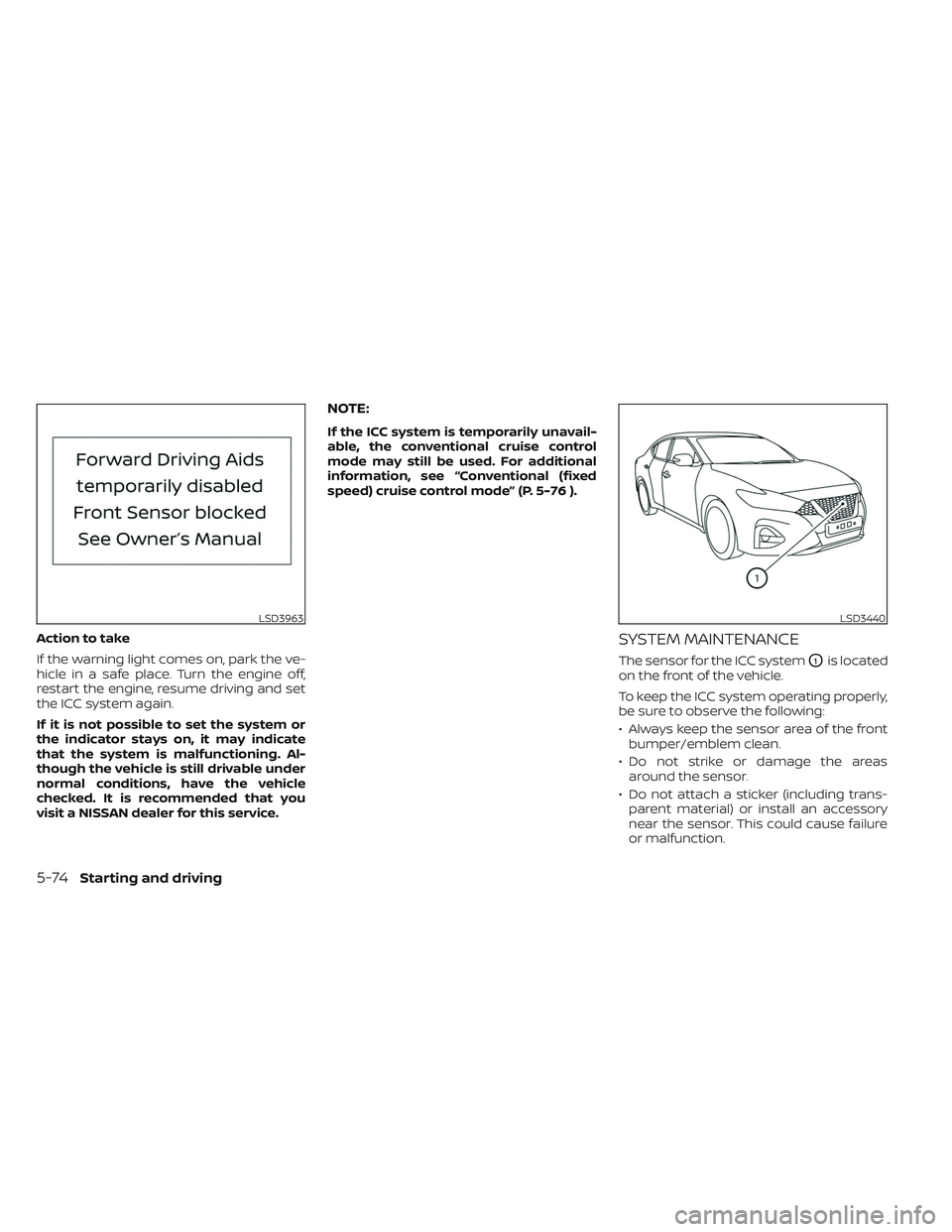
Action to take
If the warning light comes on, park the ve-
hicle in a safe place. Turn the engine off,
restart the engine, resume driving and set
the ICC system again.
If it is not possible to set the system or
the indicator stays on, it may indicate
that the system is malfunctioning. Al-
though the vehicle is still drivable under
normal conditions, have the vehicle
checked. It is recommended that you
visit a NISSAN dealer for this service.
NOTE:
If the ICC system is temporarily unavail-
able, the conventional cruise control
mode may still be used. For additional
information, see “Conventional (fixed
speed) cruise control mode” (P. 5-76 ).
SYSTEM MAINTENANCE
The sensor for the ICC systemO1is located
on the front of the vehicle.
To keep the ICC system operating properly,
be sure to observe the following:
• Always keep the sensor area of the front bumper/emblem clean.
• Do not strike or damage the areas around the sensor.
• Do not attach a sticker (including trans- parent material) or install an accessory
near the sensor. This could cause failure
or malfunction.
LSD3963LSD3440
5-74Starting and driving
Page 314 of 494
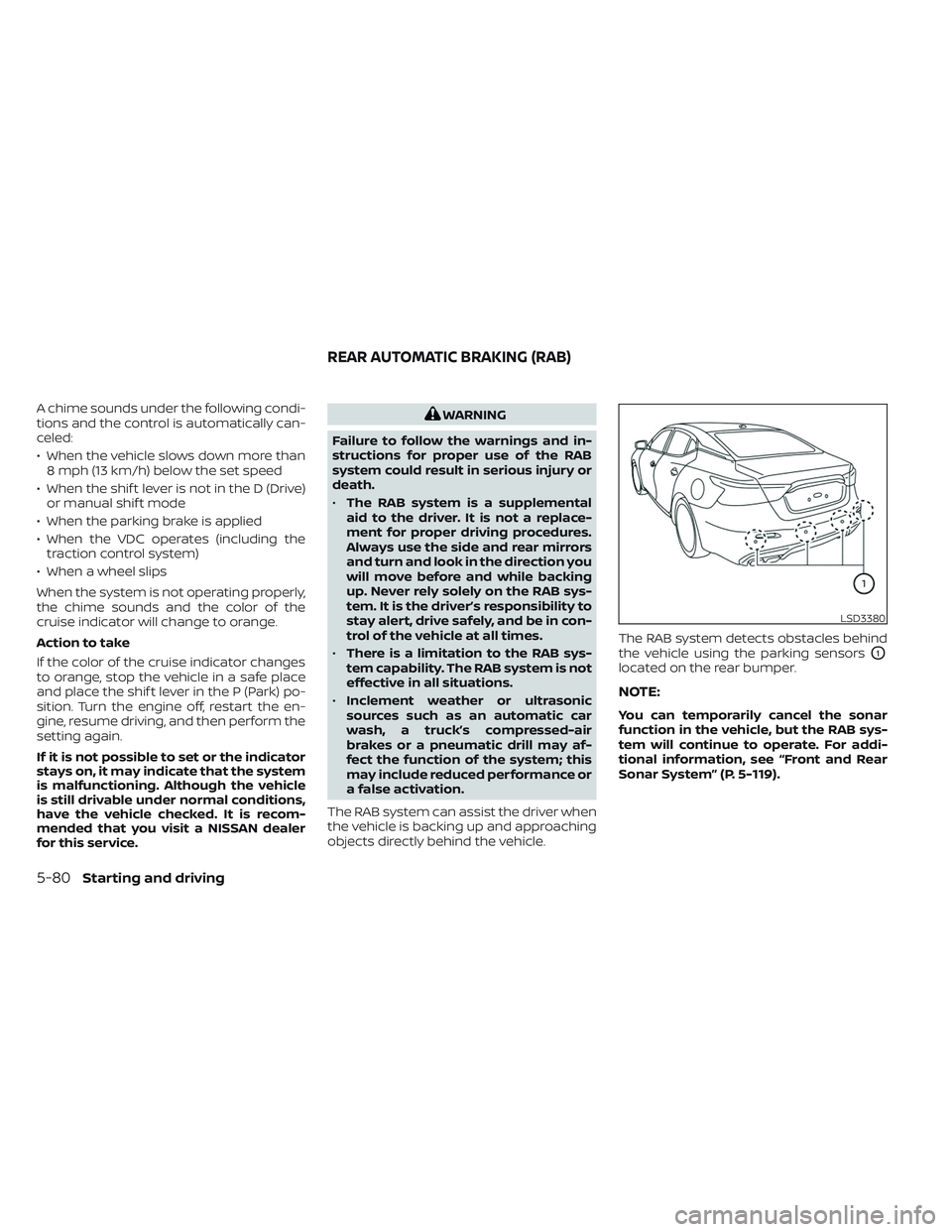
A chime sounds under the following condi-
tions and the control is automatically can-
celed:
• When the vehicle slows down more than8 mph (13 km/h) below the set speed
• When the shif t lever is not in the D (Drive) or manual shif t mode
• When the parking brake is applied
• When the VDC operates (including the traction control system)
• When a wheel slips
When the system is not operating properly,
the chime sounds and the color of the
cruise indicator will change to orange.
Action to take
If the color of the cruise indicator changes
to orange, stop the vehicle in a safe place
and place the shif t lever in the P (Park) po-
sition. Turn the engine off, restart the en-
gine, resume driving, and then perform the
setting again.
If it is not possible to set or the indicator
stays on, it may indicate that the system
is malfunctioning. Although the vehicle
is still drivable under normal conditions,
have the vehicle checked. It is recom-
mended that you visit a NISSAN dealer
for this service.WARNING
Failure to follow the warnings and in-
structions for proper use of the RAB
system could result in serious injury or
death.
• The RAB system is a supplemental
aid to the driver. It is not a replace-
ment for proper driving procedures.
Always use the side and rear mirrors
and turn and look in the direction you
will move before and while backing
up. Never rely solely on the RAB sys-
tem. It is the driver’s responsibility to
stay alert, drive safely, and be in con-
trol of the vehicle at all times.
• There is a limitation to the RAB sys-
tem capability. The RAB system is not
effective in all situations.
• Inclement weather or ultrasonic
sources such as an automatic car
wash, a truck’s compressed-air
brakes or a pneumatic drill may af-
fect the function of the system; this
may include reduced performance or
a false activation.
The RAB system can assist the driver when
the vehicle is backing up and approaching
objects directly behind the vehicle. The RAB system detects obstacles behind
the vehicle using the parking sensors
O1
located on the rear bumper.
NOTE:
You can temporarily cancel the sonar
function in the vehicle, but the RAB sys-
tem will continue to operate. For addi-
tional information, see “Front and Rear
Sonar System” (P. 5-119).
LSD3380
REAR AUTOMATIC BRAKING (RAB)
5-80Starting and driving
Page 353 of 494
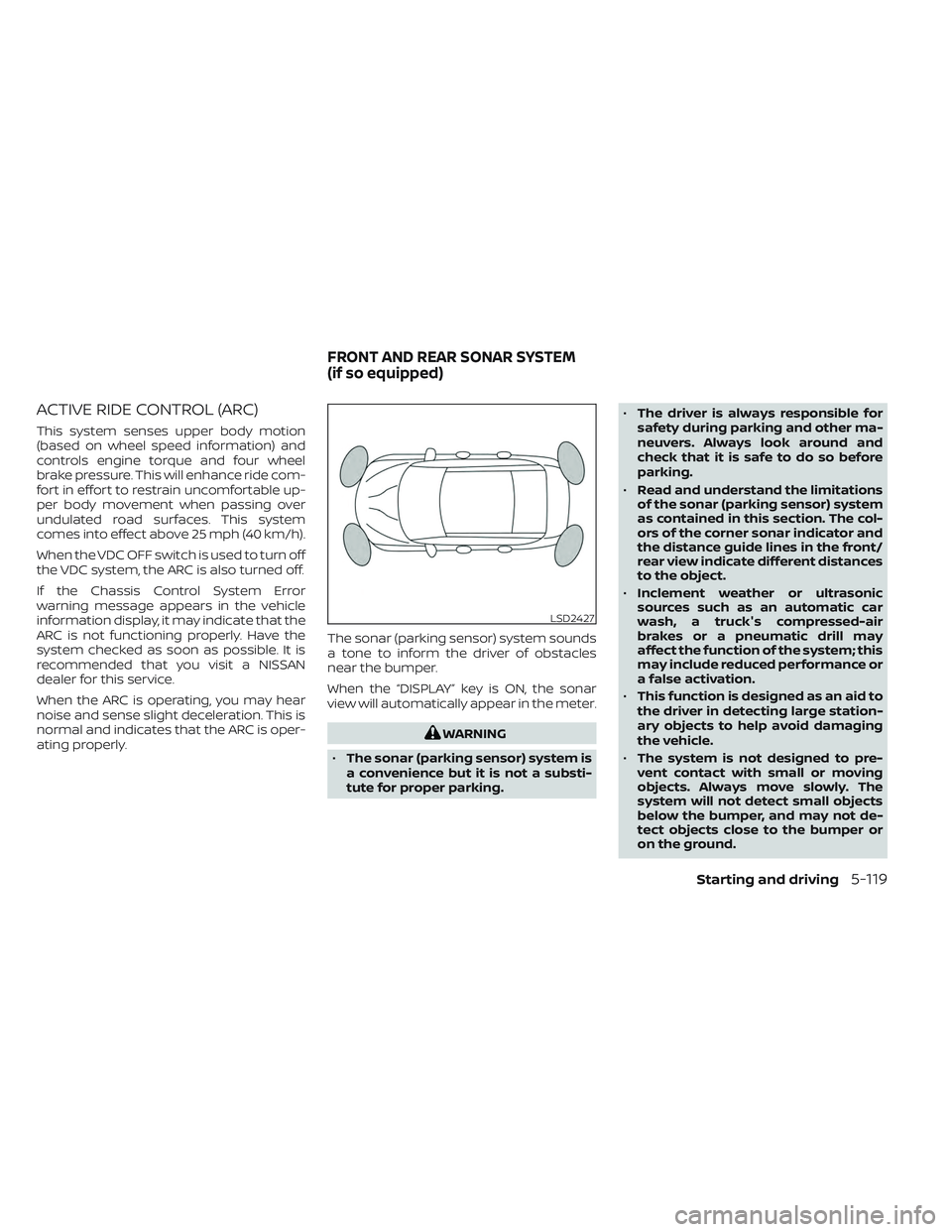
ACTIVE RIDE CONTROL (ARC)
This system senses upper body motion
(based on wheel speed information) and
controls engine torque and four wheel
brake pressure. This will enhance ride com-
fort in effort to restrain uncomfortable up-
per body movement when passing over
undulated road surfaces. This system
comes into effect above 25 mph (40 km/h).
When the VDC OFF switch is used to turn off
the VDC system, the ARC is also turned off.
If the Chassis Control System Error
warning message appears in the vehicle
information display, it may indicate that the
ARC is not functioning properly. Have the
system checked as soon as possible. It is
recommended that you visit a NISSAN
dealer for this service.
When the ARC is operating, you may hear
noise and sense slight deceleration. This is
normal and indicates that the ARC is oper-
ating properly.The sonar (parking sensor) system sounds
a tone to inform the driver of obstacles
near the bumper.
When the “DISPLAY” key is ON, the sonar
view will automatically appear in the meter.
WARNING
• The sonar (parking sensor) system is
a convenience but it is not a substi-
tute for proper parking. •
The driver is always responsible for
safety during parking and other ma-
neuvers. Always look around and
check that it is safe to do so before
parking.
• Read and understand the limitations
of the sonar (parking sensor) system
as contained in this section. The col-
ors of the corner sonar indicator and
the distance guide lines in the front/
rear view indicate different distances
to the object.
• Inclement weather or ultrasonic
sources such as an automatic car
wash, a truck's compressed-air
brakes or a pneumatic drill may
affect the function of the system; this
may include reduced performance or
a false activation.
• This function is designed as an aid to
the driver in detecting large station-
ary objects to help avoid damaging
the vehicle.
• The system is not designed to pre-
vent contact with small or moving
objects. Always move slowly. The
system will not detect small objects
below the bumper, and may not de-
tect objects close to the bumper or
on the ground.
LSD2427
FRONT AND REAR SONAR SYSTEM
(if so equipped)
Starting and driving5-119
Page 363 of 494
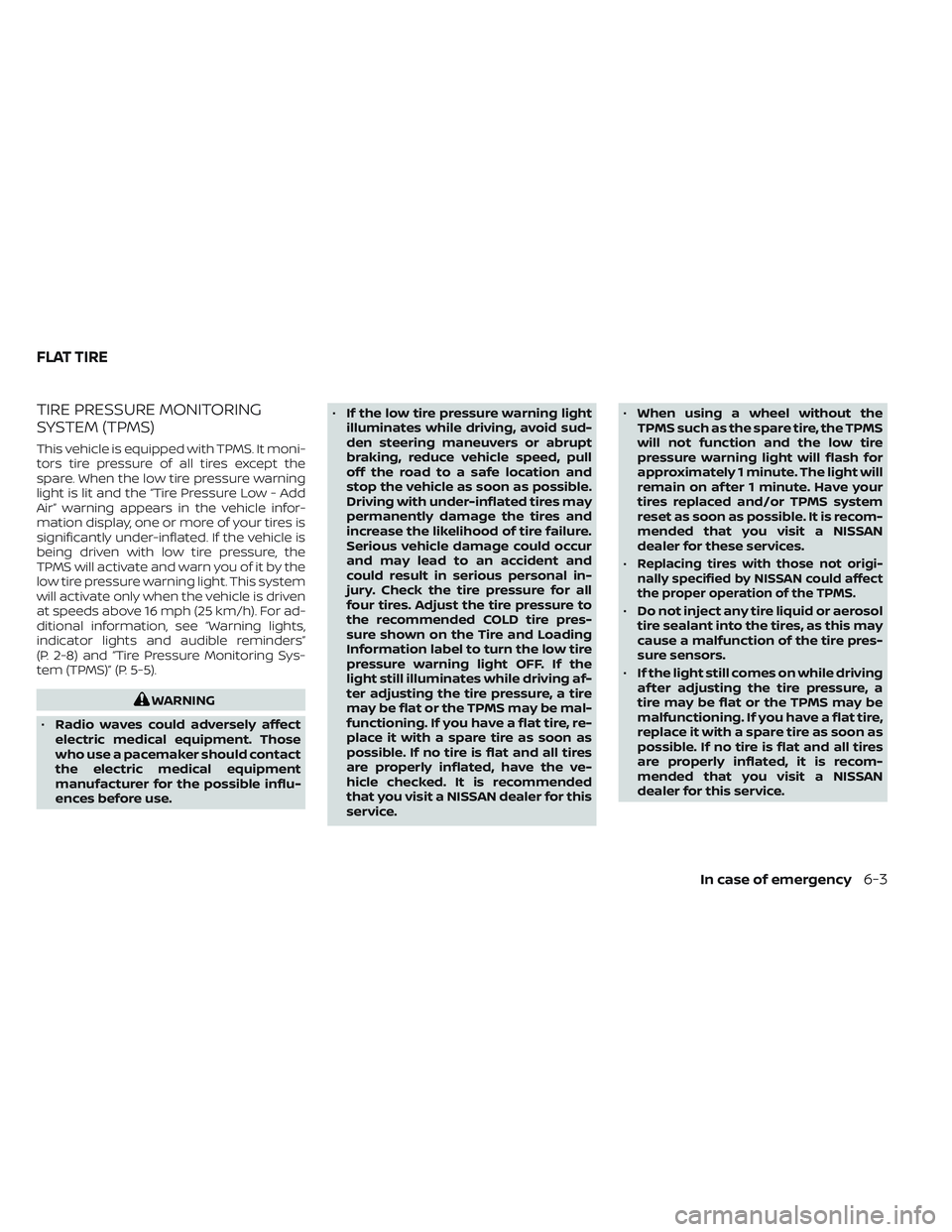
TIRE PRESSURE MONITORING
SYSTEM (TPMS)
This vehicle is equipped with TPMS. It moni-
tors tire pressure of all tires except the
spare. When the low tire pressure warning
light is lit and the “Tire Pressure Low - Add
Air” warning appears in the vehicle infor-
mation display, one or more of your tires is
significantly under-inflated. If the vehicle is
being driven with low tire pressure, the
TPMS will activate and warn you of it by the
low tire pressure warning light. This system
will activate only when the vehicle is driven
at speeds above 16 mph (25 km/h). For ad-
ditional information, see “Warning lights,
indicator lights and audible reminders”
(P. 2-8) and “Tire Pressure Monitoring Sys-
tem (TPMS)” (P. 5-5).
WARNING
• Radio waves could adversely affect
electric medical equipment. Those
who use a pacemaker should contact
the electric medical equipment
manufacturer for the possible influ-
ences before use. •
If the low tire pressure warning light
illuminates while driving, avoid sud-
den steering maneuvers or abrupt
braking, reduce vehicle speed, pull
off the road to a safe location and
stop the vehicle as soon as possible.
Driving with under-inflated tires may
permanently damage the tires and
increase the likelihood of tire failure.
Serious vehicle damage could occur
and may lead to an accident and
could result in serious personal in-
jury. Check the tire pressure for all
four tires. Adjust the tire pressure to
the recommended COLD tire pres-
sure shown on the Tire and Loading
Information label to turn the low tire
pressure warning light OFF. If the
light still illuminates while driving af-
ter adjusting the tire pressure, a tire
may be flat or the TPMS may be mal-
functioning. If you have a flat tire, re-
place it with a spare tire as soon as
possible. If no tire is flat and all tires
are properly inflated, have the ve-
hicle checked. It is recommended
that you visit a NISSAN dealer for this
service. •
When using a wheel without the
TPMS such as the spare tire, the TPMS
will not function and the low tire
pressure warning light will flash for
approximately 1 minute. The light will
remain on af ter 1 minute. Have your
tires replaced and/or TPMS system
reset as soon as possible. It is recom-
mended that you visit a NISSAN
dealer for these services.
•
Replacing tires with those not origi-
nally specified by NISSAN could affect
the proper operation of the TPMS.
• Do not inject any tire liquid or aerosol
tire sealant into the tires, as this may
cause a malfunction of the tire pres-
sure sensors.
• If the light still comes on while driving
af ter adjusting the tire pressure, a
tire may be flat or the TPMS may be
malfunctioning. If you have a flat tire,
replace it with a spare tire as soon as
possible. If no tire is flat and all tires
are properly inflated, it is recom-
mended that you visit a NISSAN
dealer for this service.
FLAT TIRE
In case of emergency6-3
Page 403 of 494
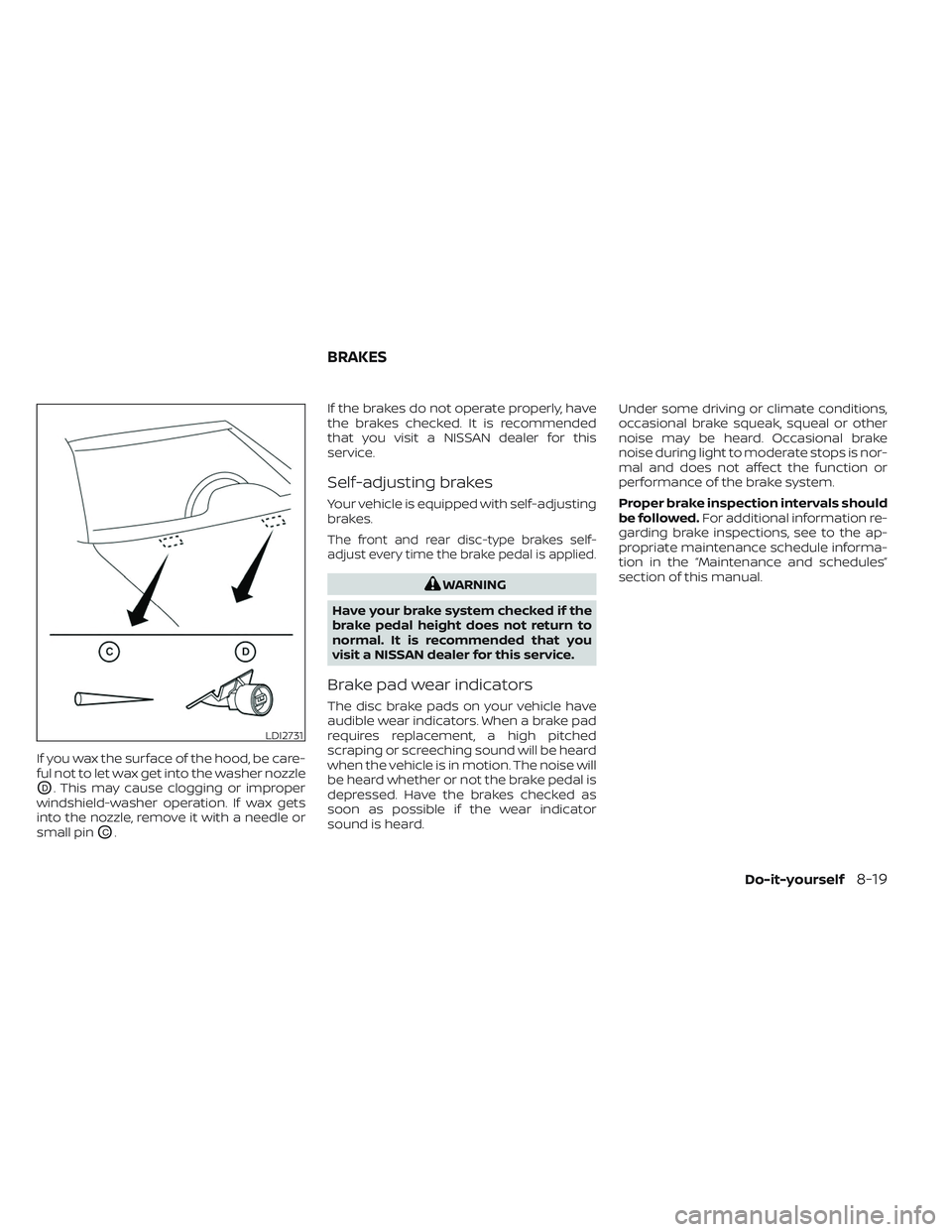
If you wax the surface of the hood, be care-
ful not to let wax get into the washer nozzle
OD. This may cause clogging or improper
windshield-washer operation. If wax gets
into the nozzle, remove it with a needle or
small pin
OC. If the brakes do not operate properly, have
the brakes checked. It is recommended
that you visit a NISSAN dealer for this
service.
Self-adjusting brakes
Your vehicle is equipped with self-adjusting
brakes.
The front and rear disc-type brakes self-
adjust every time the brake pedal is applied.
WARNING
Have your brake system checked if the
brake pedal height does not return to
normal. It is recommended that you
visit a NISSAN dealer for this service.
Brake pad wear indicators
The disc brake pads on your vehicle have
audible wear indicators. When a brake pad
requires replacement, a high pitched
scraping or screeching sound will be heard
when the vehicle is in motion. The noise will
be heard whether or not the brake pedal is
depressed. Have the brakes checked as
soon as possible if the wear indicator
sound is heard. Under some driving or climate conditions,
occasional brake squeak, squeal or other
noise may be heard. Occasional brake
noise during light to moderate stops is nor-
mal and does not affect the function or
performance of the brake system.
Proper brake inspection intervals should
be followed.
For additional information re-
garding brake inspections, see to the ap-
propriate maintenance schedule informa-
tion in the “Maintenance and schedules”
section of this manual.
LDI2731
BRAKES
Do-it-yourself8-19
Page 481 of 494

Mirror...........................3-27Automatic anti-glare inside
mirror.....................3-27,3-28
Heatedmirrors..................3-29
Outsidemirrorcontrol ............3-28
Outsidemirrors .................3-28
Vanitymirror....................3-26
Mirrors..........................3-27
Moonroof ........................2-72
Moving Object Detection (MOD) .......4-23
N
NISSAN Intelligent Key® battery discharge
indicator.........................5-13
NISSAN Intelligent Key®...............3-2
NISSAN Vehicle Immobilizer System ....2-42
NissanConnect® Owner's Manual .......4-2
O
Octane rating (See fuel octane rating) . . .10-6
Odometer........................2-4
Oil..............................10-2 Capacities and recommended
fuel/lubricants ..................10-2
Changing engine oil filter ...........8-7
Changing engine oil ...............8-7
Checking engine oil level ...........8-6
Engine oil and oil filter
recommendation ............10-2,10-7
Engine oil viscosity ...............10-7 Engine oil
.......................8-6
Outsidemirrorcontrol ..............3-28
Outsidemirrors ...................3-28
Overhead sunglasses holder .........2-66
Overheat.........................6-11 Ifyourvehicleoverheats ...........6-11
Owner's manual order form .........10-23
Owner's manual/service manual order
information......................10-23
P
Parkingbrake.....................5-22
Parking..........................5-22 Parking brake operation ...........5-22
Parking/parkingonhills...........5 -111
Personal lights ....................2-76
Poweroutlet......................2-62
Powersteeringfluid.................8-11
Powersteering....................5 -112
Power............................3-5 Power door locks .................3-5
Poweroutlet....................2-62
Powerrearwindows..............2-70
Powersteeringfluid...............8-11
Powersteeringsystem ...........5 -112
Powerwindows.................2-69
Rearpowerwindows .............2-70
Precautions.......................8-2 Maintenance precautions ...........8-2
Precautions on booster
seats..................1-28, 1-34, 1-38 Precautions on child
restraints...............1-28, 1-34, 1-38
Precautionsonseatbeltusage ......1-11
Precautions on supplemental restraint
system .......................
.1-41
Precautions when starting and
driving.........................5-4
Push starting ......................6-11
R
Radio...........................4-34
Car phone or CB radio ............4-34
Rain-sensing auto wiper system .......2-44
Readiness for inspection maintenance
(I/M) test ........................10-22
Rear Automatic Braking (RAB) .........5-80
RearCrossTrafficAlert(RCTA).........5-47
Rear Door Alert ....................2-26
Rear power sunshade ...............2-74
Rearpowerwindows ...............2-70
Rearseat ........................ .1-5
Rear sun shade ....................2-74
Rear window and outside mirror
defrosterswitch...................2-45
RearViewMonitor...................4-3
Recommended Fluids ...............10-2
Recorders.......................10-22 EventData ....................10-22
Refrigerant recommendation .........10-2
Registering a vehicle in another
country .........................10-11
11-5
Page 482 of 494
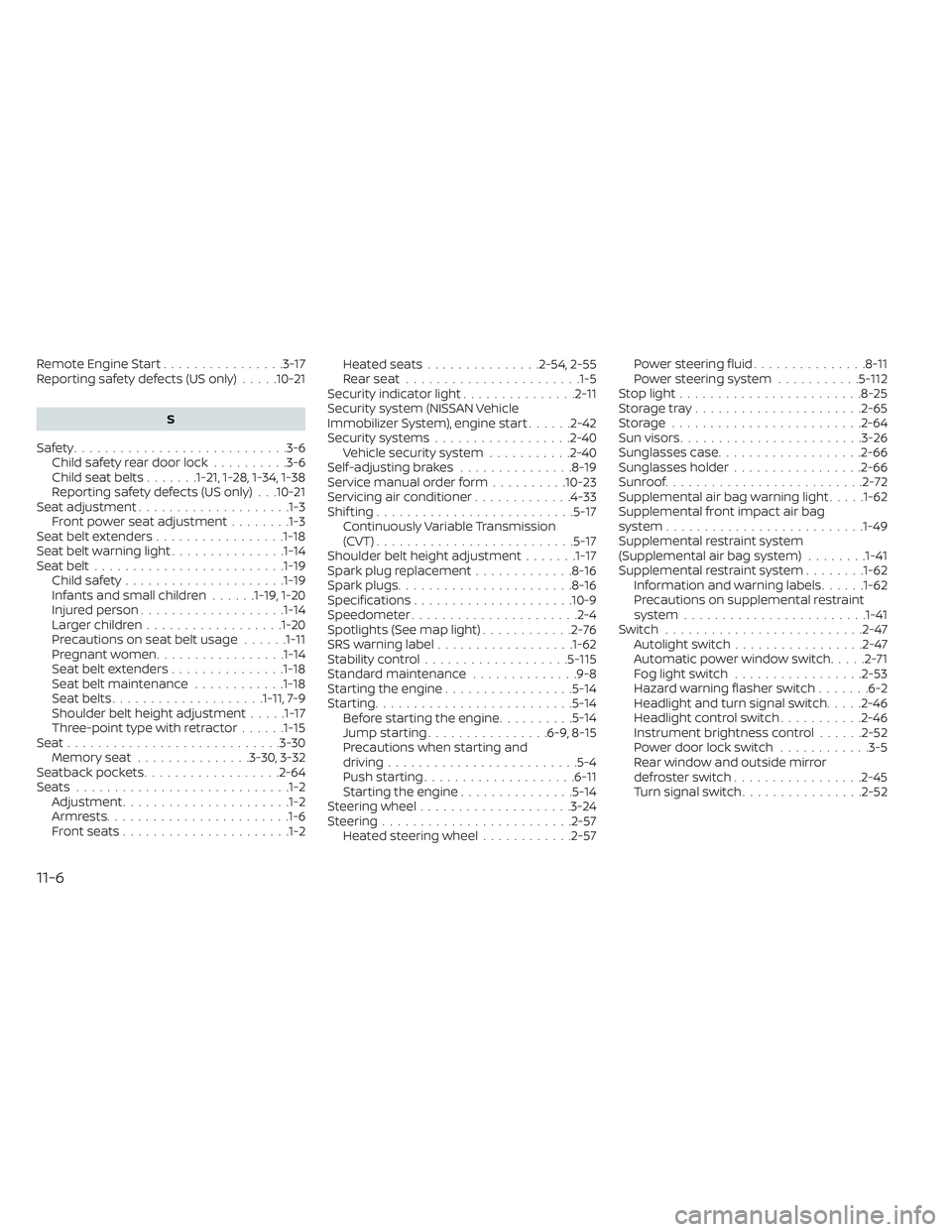
Remote Engine Start................3-17
Reporting safety defects (US only) .....10-21
S
Safety............................3-6
Child safety rear door lock ..........3-6
Childseatbelts.......1-21, 1-28, 1-34, 1-38
Reporting safety defects (US only) . . .10-21
Seat adjustment ....................1-3
Front power seat adjustment ........1-3
Seat belt extenders .................1-18
Seatbeltwarninglight.............. .1-14
Seatbelt.........................1-19 Childsafety.................... .1-19
Infants and small children ......1-19, 1-20
Injuredperson.................. .1-14
Largerchildren................. .1-20
Precautions on seat belt usage ......1-11
Pregnant women .................1-14
Seat belt extenders ...............1-18
Seat belt maintenance ............1-18
Seatbelts................... .1-11, 7-9
Shoulder belt height adjustment .....1-17
Three-pointtypewithretractor......1-15
Seat............................3-30 Memory seat ...............3-30,3-32
Seatback pockets ..................2-64
Seats ........................... .1-2
Adjustment ..................... .1-2
Armrests....................... .1-6
Frontseats..................... .1-2Heatedseats...............2-54,2-55
Rearseat ......................
.1-5
Security indicator light ...............2-11
Security system (NISSAN Vehicle
Immobilizer System), engine start ......2-42
Security systems ..................2-40
Vehicle security system ...........2-40
Self-adjustingbrakes ...............8-19
Service manual order form ..........10-23
Servicing air conditioner .............4-33
Shifting..........................5-17 Continuously Variable Transmission
(CVT) ..........................5-17
Shoulder belt height adjustment .......1-17
Spark plug replacement .............8-16
Spark plugs .......................8-16
Specifications .....................10-9
Speedometer ......................2-4
Spotlights(Seemaplight)............2-76
SRS warning label ..................1-62
Stability control ...................5 -115
Standard maintenance ..............9-8
Starting the engine .................5-14
Starting..........................5-14
Before starting the engine ..........
5-14
Jumpstarting................6-9,8-15
Precautions when starting and
driving.........................5-4
Push starting ....................6-11
Starting the engine ...............5-14
Steering wheel ....................3-24
Steering.........................2-57 Heated steering wheel ............2-57 Powersteeringfluid...............8-11
Powersteeringsystem ...........5
-112
Stoplight........................8-25
Storagetray......................2-65
Storage .........................2-64
Sunvisors........................3-26
Sunglasses case ...................2-66
Sunglasses holder .................2-66
Sunroof ..........................2-72
Supplemental air bag warning light .....1-62
Supplemental front impact air bag
system ......................... .1-49
Supplemental restraint system
(Supplemental air bag system) ........1-41
Supplemental restraint system ........1-62
Information and warning labels ......1-62
Precautions on supplemental restraint
system ....................... .1-41
Switch ..........................2-47 Autolightswitch.................2-47
Automaticpowerwindowswitch.....2-71
Foglightswitch .................2-53
Hazard warning flasher switch .......6-2
Headlight and turn signal switch .....2-46
Headlightcontrolswitch...........2-46
Instrument brightness control ......2-52
Power door lock switch ............3-5
Rear window and outside mirror
defrosterswitch.................2-45
Turn signal switch ................2-52
11-6